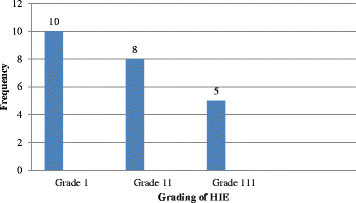Incidence and short term outcomes of neonates with hypoxic ischemic encephalopathy in a Peri Urban teaching hospital, Uganda: a prospective cohort study
- PMID: 29556412
- PMCID: PMC5840790
- DOI: 10.1186/s40748-018-0074-4
Incidence and short term outcomes of neonates with hypoxic ischemic encephalopathy in a Peri Urban teaching hospital, Uganda: a prospective cohort study
Abstract
Background: Hypoxic Ischemic Encephalopathy carries high case fatality rates ranging between 10-60%, with 25% of survivors have an adverse long-term neurodevelopment outcome. Despite the above, there is paucity of data regarding its magnitude and short term outcomes in a low resource setting like Uganda. Therefore we set out to determine the incidence and short term outcomes of Newborns with Hypoxic Ischemic Encephalopathy at St.Francis Hospital, Nsambya.
Methods: This was a Prospective Cohort study conducted between October 2015 and January 2016 at St. Francis Hospital, Nsambya, Kampala- Uganda. Term Newborn babies were enrolled. Umbilical cord arterial blood gas analysis was done for Newborns with low Apgar scores at 5 min. Clinical examination was done on all newborns within 48 h of life, for features of encephalopathy. Neonates with Hypoxic Ischemic Encephalopathy were followed up by a daily clinical examination and a short term outcome was recorded on day seven.
Results: The incidence of Hypoxic Ischemic Encephalopathy was 30.6 cases per 1000 live births. The majority, 10 (43.5%) had mild Hypoxic Ischemic Encephalopathy, followed by 8 (34.8%), 5 (21.7%) that had moderate and severe Hypoxic Ischemic Encephalopathy respectively. A total of (6) 26% died, and (15) 65.2% were discharged within 1 week. Lack of a nutritive suckling reflex (nasogastric feeding), poor Moro reflex, and requirement for respiratory support (oxygen therapy by nasal prongs) were the common complications by day seven.
Conclusions: The burden of Hypoxic Ischemic Encephalopathy is high with a case fatality rate of 26%. There is need to conduct a longitudinal study to determine the long term complications of HIE.
Keywords: Arterial blood gases; Hypoxic ischemic encephalopathy; Intrapartum asphyxia; Newborn; Short term outcomes.
Conflict of interest statement
NH: MBCHB, MMED (PAED), Department of Paediatrics and Child Health, Bethany Women and Family Hospital. NMM: MBCHB, MMED (Paed), Honorary Lecturer, Department of Paediatrics and Child Health, Mother Kevin Post Graduate Medical School, Uganda Martyrs University- Nkozi. SR: MBCHB, MMED (Paed), Honorary Lecturer, Department of Paediatrics and Child Health, Mother Kevin Post Graduate Medical School, Uganda Martyrs University- Nkozi. NVK: MBChB, MMED (Paed) MUK, Cert Neon (SA), Honorary Lecturer, Department of Paediatrics and Child Health, Mother Kevin Post Graduate Medical School, Uganda Martyrs University- Nkozi. EM: Honorary Lecture Department of Paediatrics and Child Health, Makerere University and Mother Kevin Post Graduate School: Uganda Martyrs University, Nkozi.Ethical approval was sought and obtained from the Institutional Review Board of St. Francis Hospital, Nsambya before commencement of the study. Written informed consent/permission was also obtained from mothers for their Newborn babies to participate in the study at admission or the beginning of labor process.Consent for publication of information got from this study was obtained from mothers before commencement of study.The authors declare that they have no competing interests.Springer Nature remains neutral with regard to jurisdictional claims in published maps and institutional affiliations.
Figures
References
-
- UNICEF W, World Bank. Levels and trends in child mortality. 2014. Report No.
-
- WHO. Countdown to 2015, stock of Maternal and Newborn survival 2010. World Health Organisation. 2011. Report No.
-
- Gunn AJ, Bennet L. Cerebral hypothermia in the Management of Hypoxic-Ischemic Encephalopathy. NeoReviews. 2002;3(6):e116–ee22. doi: 10.1542/neo.3-6-e116. - DOI
LinkOut - more resources
Full Text Sources
Other Literature Sources



